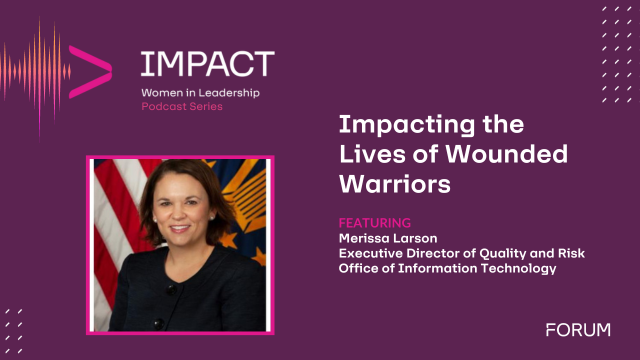Following the Electronic Health Records Modernization fireside chat during the FedHealthIT100 event, requests were made to hear an Industry perspective. One of the final events for 2020 – MHS GENESIS: What’s Working & New Opportunities for Industry – brought together executives from the Military Health System (MHS) GENESIS Leidos Partnership for Defense Health (LPDH) for an exclusive discussion with Industry on their role in deploying this system. Susan Sharer, CEO, MileMarker10, served as moderator, asking key questions about the roadmap and how Industry partners are able to get involved.
Below are seven key takeaways from this engaging event.
Our thanks to our panelists who discussed what’s working, areas for expansion, and opportunities for Industry as the Department of Defense (DOD) continues its rollout of the MHS GENESIS implementation.

An Update on the MHS GENESIS Roadmap
PJ Kennedy, Chief Engineer, Leidos Partnership for Defense Health, kicked things off with an overview of the project’s capability release roadmap. LPDH considers the injection of new capabilities in the production baseline twice a year, typically during the February/March and August/September timeframes. This approach allows new enhancements and features as well as upgrades to existing capability to be added and tested prior to implementation within the production Electronic Health Record (EHR). As the deployment progresses, developing technology and innovation continues to spur the need for expansion of capabilities.
The Mindset on Moving to the Cloud in the Federal Environment has Changed
When it comes to the cloud, Steve Wuerthele, Associate Director and Senior Technology Architect, Accenture Federal Services, shared that there has been a huge positive shift in embracing the movement. One key area of need he identified involves ensuring that new partners are approved for use in a FedRAMP environment. Planning ahead, ensuring certification, and understanding restrictions is key to avoiding delays. Wuerthele also shared that there is currently a great demand for manpower with hands-on deployment experience in the GovCloud environment.
David Waltman, Vice President, Strategy and Technology, Cerner Government Services, shared that as development continues, more components of the MHS GENESIS architecture are built natively for the cloud environment. This continuing evolution allows the team to leverage scalability programs and to take advantage of available shared services. He also agreed with Wuerthele that there are opportunities for industry partnerships as the team shifts to a continuous integration, continuous deployment (CI/CD) pipeline operation.
Telehealth Needs and Capabilities are Exponentially Rising
The concept of virtually connecting with medical staff to receive care is not new, however, in recent months the demand for this type of care has increased. Currently, LPDH is leveraging the code base created by the Department of Veterans Affairs’ (VA’s) Office of Connected Care to develop, certify, and deploy telehealth capabilities at select Military Treatment Facilities. The Defense Health Agency (DHA) plans to begin leveraging this capability across MHS in Q1 of calendar year 2021.
Kevin Bunker, President, North America Dental Core, Henry Schein One, addressed the need to help patients see the benefit of more controlled access through being able to virtually make an appointment, check-in, and fill out forms. Wuerthele spoke to DHA leveraging the progress and advancements VA has made in the telehealth space to build a new technology stack. A new architecture (to DHA), a more robust patient and provider search, and efforts to remove the duplication of information is being addressed to make the process more efficient.
Security Standards and Capabilities Remain Paramount for Medical Devices and Mobile Apps
When it comes to mobile apps and devices, Kennedy indicated that building in cybersecurity at the beginning of development is the most beneficial. Wuerthele added that all new mobile apps should be prepared to demonstrate their security and compatibility with the platform prior to integration. Waltman shared that all of Cerner’s platforms are designed to expose standard APIs, allowing third party developers to collaborate and bring edge-application capabilities to the table through its Open Developer Experience.
Mobile applications are one area in which technological advancements can be seen, especially in forward operating base/deployment areas. Work is being done to share lessons learned from operations at the Garrison level to situations and areas where communications are far more limited. If forward operating bases do not have access to the cloud, perhaps cellular data can be used by clinicians as a back-up to help document patient encounters and then transfer data back into the EHR. Thinking about how to creatively meet this need while also meeting cybersecurity requirements is the trade space currently being investigated.
Training Support is Needed and Evolving as the Deployment Continues
MHS GENESIS instructors are currently needed, both for travel to deployment areas and in the transition to virtual education. While the software created is easy to learn, medical staff and patients need to become familiar with the various components of this new system. One pain point mentioned during the discussion was the lack of connection to external interfaces during the training process. Additionally, given the system-to-system training that is required, a need for further automation has emerged. Currently, once a training session is complete, the system must be restored to its original state before each subsequent group. As multiple waves of deployment overlap this will become an even greater challenge.
New methods of training are evolving as the roll-out continues. Initiatives like DHA’s Pay it Forward training program demonstrates success through its deployment of individuals who have completed the training and Go-Live event, assisting new users and sharing their real “on the job” experience at a future Go-Live site.
Deployment will continue primarily within the continental United States, while preparing for a shift to overseas in 2023. Industry partners can begin preparing now to help with regionalizing the system, addressing potential limitations, and on the ground training. Preparation will include having cleared resources and the ability to travel and train outside the US.
Interoperability Challenges have Shifted
Both Kennedy and Waltman shared that as DOD and VA continue to work towards one data system and one repository, interoperability obstacles between the two are largely resolved. This allows focus to expand outward to collaborating with community partners and providers. Improving interoperability with these providers remains critical for both DOD and VA beneficiaries. Wuerthele addressed that functional integration challenges do exist and are being addressed as both systems work to integrate. New priorities like standardizing terminology for both Agencies has risen to the forefront.
Collaboration is the Key to Success
Deploying an EHR system through which patients and beneficiaries receive the best care remains the end goal for Government and Industry. Providing seamless, integrated care that follows an individual throughout their Military career, and as they transition to Veteran status, requires extensive collaboration not only between DHA and VA – but with Industry as well. The partnership between traditional Government contractors and commercial companies has proven to be very beneficial and all parties remain dedicated to working together to meet success.
As the implementation continues, LPDH welcomes the opportunity for Industry to share their innovative ideas and solutions. To learn more or get involved, email the LPDH Group here.
Thank you to our panelists:
PJ Kennedy, Chief Engineer, Leidos Partnership for Defense Health; Steve Wuerthele, Associate Director and Senior Technology Architect, Accenture Federal Services; David Waltman, Vice President, Strategy and Technology, Cerner Government Services; and Kevin Bunker, President, North America Dental Core, Henry Schein One.












